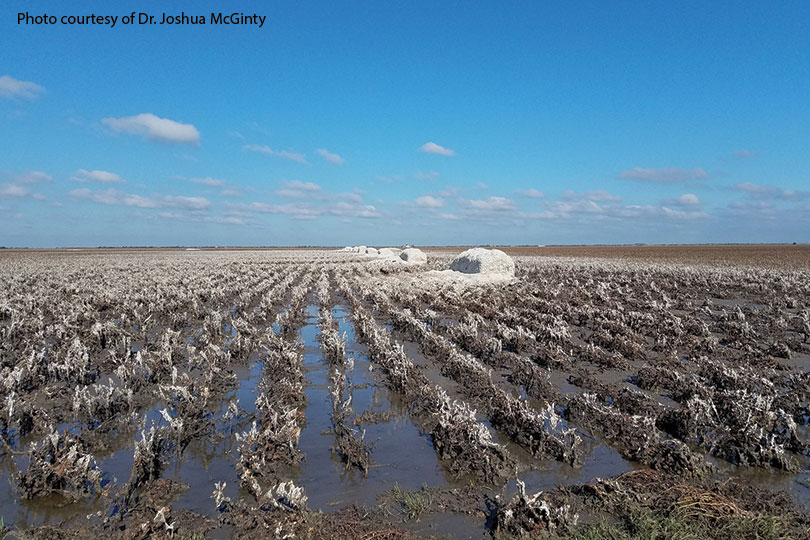By Jessica Domel
Multimedia Reporter
It was supposed to be the largest cotton crop in 11 years. Now, it sits drenched, sprouting or spread into trees and neighboring fields. Hurricane Harvey wreaked havoc on much of the Texas coast’s cotton crop.
“It was the crop that was going to keep some folks in business for next year. It’s going to be a rough one, getting over this,” Dr. Joshua McGinty, Texas A&M AgriLife Extension agronomist in Corpus Christi, said in an interview with the Texas Farm Bureau (TFB) Radio Network.
McGinty drove through parts of San Patricio County after Hurricane Harvey moved through the area, surveying the damage.
“Corpus Christi and all of that country south of Corpus in Nueces County is fine. The city came through it just fine. All the cotton is in good shape,” McGinty said. “We didn’t get the kind of rain they did to the north. We got four or five inches of rain and a little bit of wind, so we’re okay. As soon as you cross into San Patricio County and move north, that’s where the damage really picks up.”
A lot of conventional cotton modules in San Patricio County were stored in the field or at the gin yard when Harvey came barreling through.
“A lot of those are ripped apart, and the cotton’s scattered all over the place and sprouting. It’s a big mess because the module got torn apart and then got 20 inches of rain on it, basically,” McGinty said. “It looks pretty poor up there. Houses are pretty badly damaged. Some of these smaller communities to the north are going to be in bad shape for a long time.”
It’s clear the torn apart cotton modules are ruined, but it’s unclear how much damage some of the wrapped round bales sustained, McGinty said.
“With the amount of rain we got, the modules, whether they’re rounds or the rectangular ones, were in standing water for quite a while. They’re probably going to have to remove the bottom part of that module before they gin anything. Then, on those that were exposed where the tarps came off, we’re probably going to have to remove a bunch of the upper cotton that got wet and sprouted and turned nasty,” he said. “That leaves you with what’s in the middle, and on some of these modules, that’s not much. It may not be worth running through the gin.”
Farmers may not be able to transport some of the modules without them falling apart, according to McGinty. Those that fell apart spread cotton everywhere.
“That cotton is scattered all over the creation. I’ve seen trees that looked like they were just painted white, and all the power lines are coated in cotton. It blew all over the country up there. I didn’t see too many of the round modules torn apart, which is good,” McGinty said. “Most of our cotton is going into those round modules at this point, so they’re okay. I saw a few that were ripped apart and maybe rolled around a little bit, but as long as they didn’t sit in standing water, they’ll be alright.”
Ginning the cotton that survived may be tough for some farmers as at least one gin in the area sustained heavy damage.
“We went to Bayside Gin, and we don’t know everything just yet, but talking to the manager, they could be out for the rest of the season. There’s no telling,” McGinty said. “The problem with those gins is, if something breaks, you can’t just buy it. It has to be custom built and fabricated, so it could be awhile before they’re back up and running.”
Another gin in the area could also be out of commission, but it’s unclear just how much damage it sustained right now.
It’s not just one farmer or business man’s loss, McGinty explained. The cotton sector is a vital part of communities in the Coastal Bend and South Texas.
“Cotton is a major part of the economy down here, and this year especially. We were set up with such a good crop. The gins were running at full capacity. Everybody was busy with it, and now to lose a lot of that is heartbreaking,” McGinty said.
It’s unclear just how much, if any, will be covered by those with insurance.
“We do have, in some cases, some insurance to cover those modules that are sitting on the gin yard or out in the field that were lost, but I think there’s a cap on the total amount that’s available here along the Gulf Coast. I think we’re still going to see losses, regardless of what the insurance does,” McGinty said.
Further up t


I think the “Cotton Disaster” as I’m calling it will bring up prices for clothes, also will cause some more jobs to be offered to help fix it.